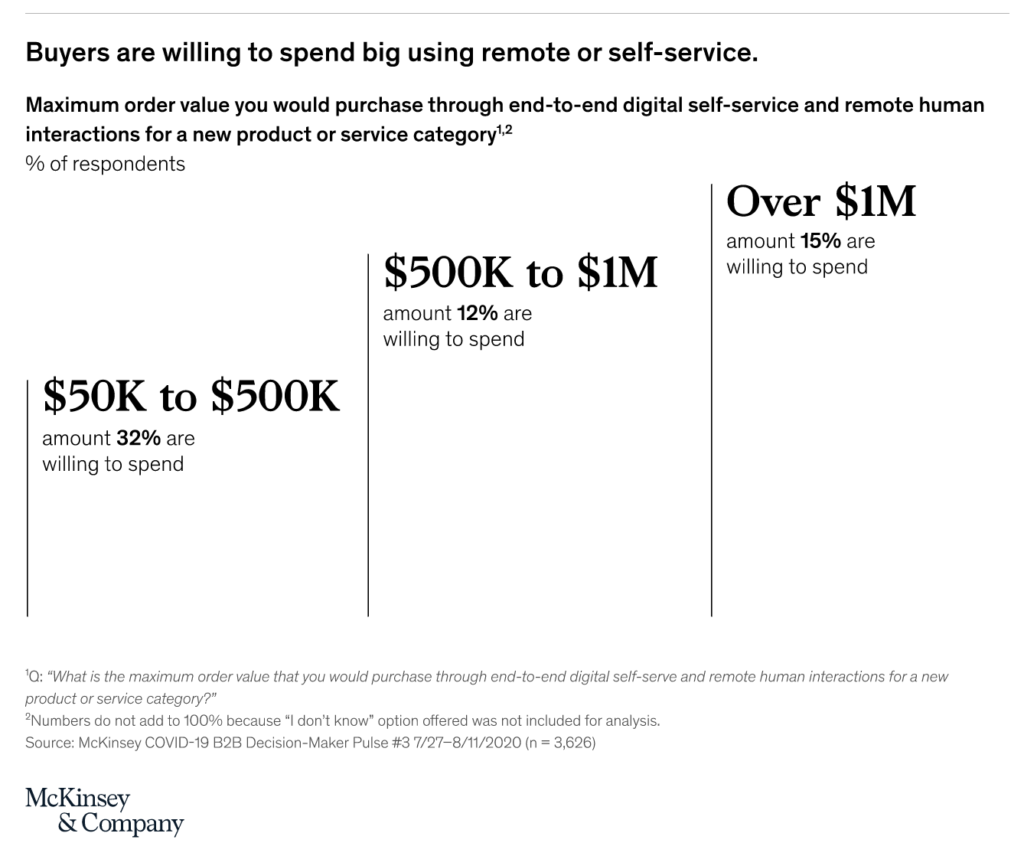Have you ever heard of the eight-legged sales call?
That’s when you gather up a selling team of four people, many times consisting of an executive, a sales manager, an account executive and a solutions consultant — hence the eight legs — put them on a plane and send them out into the field to meet a prospective customer at their home headquarters. You typically spend a couple of nights in the company’s hometown, facilitating a few days chock full of meetings with key stakeholders for your product, service and/or solution. Through it all, you transfer knowledge, gain information, and strengthen relationships.
The eight-legged sales call had its benefits. It was very effective at building those valuable, trusting relationships. It was a staple of growth strategies since … there’s been growth strategies! However, I would argue the eight-legged sales call has never been super efficient. The time and expense of these meetings was a huge budget item.
I will also argue the eight-legged sales call has gone the way of the dodo, extinct and not returning because of how the world of B2B selling has changed in just the last few years.
How B2B sales has changed forever
The purpose of the eight-legged sales call was always clear: Gather and transfer information to and from a customer, and build relationships at various levels within the company, all of which is still very necessary in B2B selling. However, today’s B2B buyer is decidedly digital-first. Prior to the pandemic bursting across the globe in early 2020, the buying journey had been trending toward digital. Then, when the pandemic erupted, buyers and sellers jumped whole-heartedly and feet first into digital processes, most without even looking.
What started as a knee-jerk crisis response in early- to mid-2020 has now become the “new normal.” As such, it’s having huge implications on how revenue teams market and sell.
McKinsey reports that over 75% of both buyers and sellers now prefer digital self-serve and remote human engagement over face-to-face interactions. And, that hasn’t changed with the lifting of most lockdown restrictions.
Technology makes it easy, quick and convenient for prospective buyers and existing customers to access information, place orders and request service.
Now, I know what you might be thinking. You might be thinking that digital, e-commerce buying journeys are only the domain of small-ticket items.
Well, you’d be wrong. McKinsey reports 70 percent of B2B decision makers say they are open to making new, fully self-serve or remote purchases in excess of $50,000, and 27 percent would spend more than $500,000.
Okay, that’s from the buyers’ perspective. What about sellers?
Well, McKinsey will tell us sellers are increasingly comfortable with digital prospecting and relationship building. Our own experience as revenue team leaders will corroborate. The world is a different place. Zoom, among other things, is now a verb in our collective vocabularies.
The bottom line: Revenue teams need to evolve their processes, or else!
Selling more effectively in a post-pandemic world
B2B selling today still requires the transfer of information to and from a prospect or customer and building relationships at multiple levels. Both can be done in the new B2B selling world. The key is transferring the information when, where and how a prospective customer needs the information, making that process easy and immediate, and tailoring the information in a way it suits them.
Like always, the best selling processes are the selling processes that make it easy for prospective customers to buy. In the digital buying era, that means eliminating hurdles and facilitating engagement and conversations with leads and customers through virtual methods like online chat, email, phone, and video conferencing.
And, it even starts before that. Automated scheduling software like LeanData’s BookIt allows inbound website visitors to immediately book an appointment with the proper rep in real-time, on prospects’ own terms. It’s a best practice, and it’s a big boost felt along on the buying journey before a prospect even engages with one of your representatives.
As far as meetings go, forget the eight-legged sales call and other in-person meetings, And, in most cases, you’ll do well to forget about good old-fashioned telephone calls too. Video calls are the norm, so ensure your team has the right tech, be it Zoom, WebEx, Teams or something else, to get the job done.
At its very nature, video is a face-to-face medium, and as such, it’s a wonderful way to both build and continue to foster strong interpersonal relationships. Make certain each of your representatives has the proper equipment — lighting, as well as a stand to lift cameras to eye level — and training to facilitate engagement via video conferencing. With video conferencing, different skills and behaviors are needed as opposed to strict telephone engagement, so prepare accordingly.
In addition to technology solutions to help Sales teams prosper, the topics of team building, career development and transparent compensation have never been more important to Sales leaders. The “Great Resignation” has made it difficult to both recruit and retain the best of the best. Your team has always deserved the best from you and your organization in terms of professional development, professional success and compensation. Let them down at your own peril!
Much has change, but Trust has remained a constant
The buying journey may have changed with respect to B2B sales, but one constant remains, and that’s trust.
Prospective buyers have to have implicit trust in the people and organizations they work with in their buying journey. If trust is missing, the deal dies.
I contend that the relationship and trust between the buyer and seller can be done very effectively in this new B2B selling world. If the seller can become a ‘trusted advisor’ to the buyer, helping them along the buying journey, providing the right information when needed, and making that information relevant, trust and, ultimately, a strong relationship will be built.
The relationship becomes much more between the go-to-market team from the seller than any one individual. The account executive is the point person on a broader team whose job it is to guide buyers every step of the way along their decision making process. What once was the job of a few ‘sales’ people that happened in a series of face-to face-meetings, is now done by a number of people and teams during many different touch points along the buyer’s journey.
Don’t get me wrong, traveling to a prospect or a customer, meeting them in person and having dinner is still a great touch and a nice way to foster a relationship; it is always appreciated when it can happen. But the days of the multi-person ‘8-legged sales call’ being the primary way to sell are gone.
What’s more important is providing the buyer with the information they need, when they need it and the way they need it.










